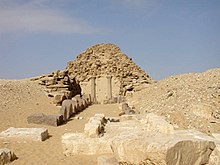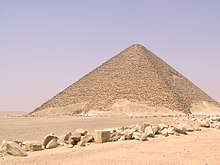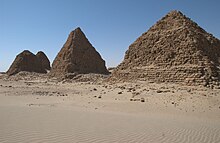In 1842, Karl Richard Lepsius produced the first modern list of pyramids – see Lepsius list of pyramids – in which he counted 67. A great many more have since been discovered. As of November 2008, 118 Egyptian pyramids have been identified.
The location of Pyramid 29, which Lepsius called the "Headless Pyramid", was lost for a second time when the structure was buried by desert sands subsequent to Lepsius' survey. It was found again only during an archaeological dig conducted in 2008.[14]
Many pyramids are in a poor state of preservation or buried by desert sands. If visible at all, they may appear as little more than mounds of rubble. As a consequence, archaeologists are continuing to identify and study previously unknown pyramid structures.
The most recent pyramid to be discovered was that of Sesheshet at Saqqara, mother of the Sixth Dynasty pharaoh Teti. The discovery was announced by Zahi Hawass, Secretary General of the Egyptian Supreme Council of Antiquities, on 11 November 2008.
All of Egypt's pyramids, except the small Third Dynasty pyramid of Zawyet el-Amwat (or Zawyet el-Mayitin), are sited on the west bank of the Nile, and most are grouped together in a number of pyramid fields. The most important of these are listed geographically, from north to south, below.
Abu Rawash
Abu Rawash is the site of Egypt's most northerly pyramid (other than the ruins of Lepsius pyramid number one) the mostly ruined Pyramid of Djedefre, son and successor of Khufu. Originally it was thought that this pyramid had never been completed, but the current archaeological consensus is that not only was it completed, but that it was originally about the same size as the Pyramid of Menkaure, which would have placed it among the half-dozen or so largest pyramids in Egypt.
Its location adjacent to a major crossroads made it an easy source of stone. Quarrying – which began in Roman times – has left little apart from about 15 courses of stone superimposed upon the natural hillock that formed part of the pyramid's core. A small adjacent satellite pyramid is in a better state of preservation.
Giza
Giza is the location of the Pyramid of Khufu (also known as the "Great Pyramid" and the "Pyramid of Cheops"); the somewhat smaller Pyramid of Khafre (or Kephren); the relatively modest-sized Pyramid of Menkaure (or Mykerinus), along with a number of smaller satellite edifices known as "Queen's pyramids"; and the Great Sphinx of Giza.
Of the three, only Khafre's pyramid retains part of its original polished limestone casing, near its apex. This pyramid appears larger than the adjacent Khufu pyramid by virtue of its more elevated location, and the steeper angle of inclination of its construction – it is, in fact, smaller in both height and volume.
The Giza pyramid complex has been a popular tourist destination since antiquity, and was popularized in Hellenistic times when the Great Pyramid was listed by Antipater of Sidon as one of the Seven Wonders of the Ancient World. Today it is the only one of those wonders still in existence.
Zawyet el-Aryan
This site, halfway between Giza and Abu Sir, is the location for two unfinished Old Kingdom pyramids. The northern structure's owner is believed to be pharaoh Nebka, while the southern structure, known as the Layer Pyramid, may be attributable to the Third Dynasty pharaoh Khaba, a close successor of Sekhemkhet. If this attribution is correct, Khaba's short reign could explain the seemingly unfinished state of this step pyramid. Today it stands around 17 m (56 ft) high; had it been completed, it is likely to have exceeded 40 m (130 ft).
Abu Sir
There are a total of fourteen pyramids at this site, which served as the main royal necropolis during the Fifth Dynasty. The quality of construction of the Abu Sir pyramids is inferior to those of the Fourth Dynasty – perhaps signaling a decrease in royal power or a less vibrant economy. They are smaller than their predecessors, and are built of low-quality local limestone.
The three major pyramids are those of Niuserre, which is also the best preserved, Neferirkare Kakai and Sahure. The site is also home to the incomplete Pyramid of Neferefre. Most of the major pyramids at Abu Sir were built similar construction techniques, comprising a rubble core surrounded by steps of mud bricks with a limestone outer casing. The largest of these 5th-Dynasty pyramids, the Pyramid of Neferirkare Kakai, is believed to have been built originally as a step pyramid some 70 m (230 ft) high and then later transformed into a "true" pyramid by having its steps filled in with loose masonry.
Saqqara
Major pyramids located here include the Pyramid of Djoser – generally identified as the world's oldest substantial monumental structure to be built of dressed stone – the Pyramid of Userkaf, the Pyramid of Teti and the Pyramid of Merikare, dating to the First Intermediate Period of Egypt. Also at Saqqara is the Pyramid of Unas, which retains a pyramid causeway that is one of the best-preserved in Egypt. Together with the pyramid of Userkaf, this pyramid was the subject of one of the earliest known restoration attempts, conducted by Khaemweset, a son of Ramesses II. Saqqara is also the location of the incomplete step pyramid of Djoser's successor Sekhemkhet known as the Buried Pyramid. Archaeologists believe that had this pyramid been completed, it would have been larger than Djoser's.
South of the main pyramid field at Saqqara is a second collection of later, smaller pyramids, including those of Pepi I, Isesi, Merenre, Pepi II and Ibi. Most of these are in a poor state of preservation.
The Fourth Dynasty pharaoh Shepseskaf either did not share an interest in, or have the capacity to undertake pyramid construction like his predecessors. His tomb, which is also sited at south Saqqara, was instead built as an unusually large mastaba and offering temple complex. It is commonly known as the Mastabat al-Fir’aun.
A previously unknown pyramid was discovered at north Saqqara in late 2008. Believed to be the tomb of Teti's mother, it currently stands approximately 5 m (16 ft) high, although the original height was closer to 14 m (46 ft).
Dahshur
This area is arguably the most important pyramid field in Egypt outside Giza and Saqqara, although until 1996 the site was inaccessible due to its location within a military base, and was relatively unknown outside archaeological circles.
The southern Pyramid of Sneferu, commonly known as the Bent Pyramid, is believed to be the first Egyptian pyramid intended by its builders to be a "true" smooth-sided pyramid from the outset; the earlier pyramid at Meidum had smooth sides in its finished state – but it was conceived and built as a step pyramid, before having its steps filled in and concealed beneath a smooth outer casing of dressed stone.
As a true smooth-sided structure, the Bent Pyramid was only a partial success – albeit a unique, visually imposing one; it is also the only major Egyptian pyramid to retain a significant proportion of its original smooth outer limestone casing intact. As such it serves as the best contemporary example of how the ancient Egyptians intended their pyramids to look.
Several kilometeres to the north of the Bent Pyramid is the last – and most successful – of the three pyramids constructed during the reign of Sneferu; the Red Pyramid is the world's first successfully completed smooth-sided pyramid. The structure is also the third largest pyramid in Egypt – after the pyramids of Khufu and Khafra at Giza.
Also at Dahshur is the pyramid known as the Pyramid of Amenemhat III, as well as a number of small, mostly ruined subsidiary pyramids.
Mazghuna
Located to the south of Dahshur, several mudbrick pyramids were built in this area in the late Middle Kingdom, perhaps for Amenemhat IV and Sobekneferu.
Lisht
Two major pyramids are known to have been built at Lisht – those of Amenemhat I and his son, Senusret I. The latter is surrounded by the ruins of ten smaller subsidiary pyramids. One of these subsidiary pyramids is known to be that of Amenemhat's cousin, Khaba II. The site which is in the vicinity of the oasis of the Faiyum, midway between Dahshur and Meidum, and about 100 kilometres south of Cairo, is believed to be in the vicinity of the ancient city of Itjtawy (the precise location of which remains unknown), which served as the capital of Egypt during the Twelfth Dynasty.
Meidum
The pyramid at Meidum is one of three constructed during the reign of Sneferu, and is believed by some to have been started by that pharaoh's father and predecessor, Huni. However, that attribution is uncertain, as no record of Huni's name has been found at the site.
It was constructed as a step pyramid, and then later converted into the first "true" smooth-sided pyramid when the steps were filled in, and an outer casing added.
The pyramid suffered several catastrophic collapses in ancient and medieval times; medieval Arab writers described it as having seven steps – although today only the three uppermost of these remain, giving the structure its odd, tower-like appearance. The hill on which the pyramid is situated is not a natural landscape feature – it is the small mountain of debris created when the lower courses and outer casing of the pyramid gave way.
Hawara
Amenemhat III was the last powerful ruler of the Twelfth Dynasty, and the pyramid he built at Hawarra, near the Faiyum, is believed to post-date the so-called "Black Pyramid" built by the same ruler at Dahshur. It is the Hawarra pyramid that is believed to have been Amenemhet's final resting place.
el-Lahun
The pyramid of Senusret II at el-Lahun is the southernmost royal-tomb pyramid structure in Egypt. Its builders reduced the amount of work necessary to construct it by ingeniously using as its foundation and core a 12-meter-high natural limestone hill.
El-Kurru
Piye, the first ruler of the Egyptian 25th dynasty, built a pyramid at El-Kurru. He was the first Egyptian pharaoh to be buried in a pyramid in centuries.
Nuri
Taharqa, a legitimate ruler and Pharaoh of Egypt, built his pyramid at Nuri. It was the largest in the area (North Sudan).
Construction dates
The following table lays out the chronology of the construction of most of the major pyramids mentioned here. Each pyramid is identified through the pharaoh who ordered it built, his approximate reign, and its location.
| Pyramid / Pharaoh | Reign | Field |
|---|---|---|
| Djoser | c. 2670 BC | Saqqara |
| Sneferu | c. 2612–2589 BC | Dashur |
| Sneferu | c. 2612–2589 BC | Meidum |
| Khufu | c. 2589–2566 BC | Giza |
| Djedefre | c. 2566–2558 BC | Abu Rawash |
| Khafre | c. 2558–2532 BC | Giza |
| Menkaure | c. 2532–2504 BC | Giza |
| Userkaf | c. 2494–2487 BC | Saqqara |
| Sahure | c. 2487–2477 BC | Abu Sir |
| Neferirkare Kakai | c. 2477–2467 BC | Abu Sir |
| Nyuserre Ini | c. 2416–2392 BC | Abu Sir |
| Amenemhat I | c. 1991–1962 BC | Lisht |
| Senusret I | c. 1971–1926 BC | Lisht |
| Senusret II | c. 1897–1878 BC | el-Lahun |
| Amenemhat III | c. 1860–1814 BC | Hawara |
| Khendjer | c. 1764–1759 BC | Saqqara |
| Piye | c. 721 BC | El-Kurru |
| Taharqa | c. 664 BC | Nuri |













No comments:
Post a Comment